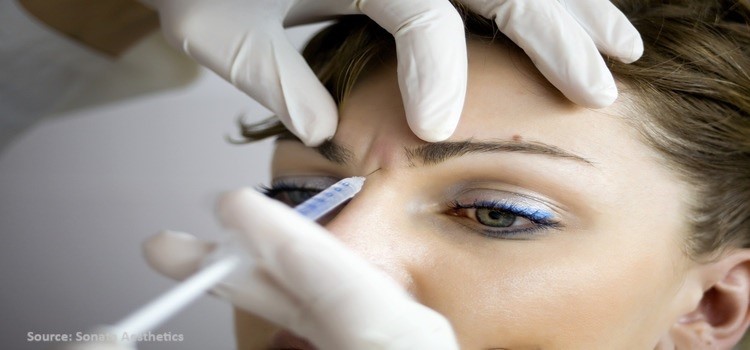The Transformative Power of Botulinum Toxin in the Healthcare and Cosmetic Industry
Introduction
The Botulinum Toxin Market has experienced remarkable growth over the past few decades, with applications spanning across the healthcare and cosmetic industries. Botulinum toxin, a neurotoxin produced by the bacterium clostridium botulinum, has become synonymous with the well-known brand Botox. It is widely used to treat a range of medical conditions and enhance physical appearance of people.
This article explores the key trends and advancements in the botulinum toxin market, highlighting its substantial impact on healthcare and cosmetics.
Role of Botulinum Toxin in the Healthcare Industry
Neurological Disorders:
Botulinum toxin, derived from the bacterium clostridium botulinum, has revolutionized the treatment of various neurological disorders. This neurotoxin has become a vital therapeutic tool in cases such as cervical dystonia, spasticity, and chronic migraines. By injecting botulinum toxin into specific muscle groups, healthcare professionals can effectively alleviate muscle spasms and associated pain, ultimately offering patients a significantly improved quality of life.
For instance, in cervical dystonia the neurotoxin's action, which involves inhibiting the release of acetylcholine a neurotransmitter responsible for muscle contractions, results in temporary muscle relaxation. This procedure has not only provided relief to those suffering from the pain and discomfort associated with these disorders. Still, it has also enhanced their overall well-being and functional capabilities, marking a pivotal advancement in the realm of neurological treatment.
For instance, in July 2021, Allergan, a subsidiary of AbbVie, officially announced that the U.S. Food and Drug Administration (FDA) approved an expansion of BOTOX's label. This expansion includes adding eight more muscles for the treatment of upper limb spasticity in adult patients. This advancement is highly significant as the upper limb spasticity is a severe neurological condition that can significantly impact the well-being of those it afflicts. It is commonly linked to conditions, such as stroke, multiple sclerosis, spinal cord injury, cerebral palsy, and traumatic brain injury.
Overactive Bladder:
For individuals grappling with the vexing and often embarrassing symptoms of overactive bladder (OAB), botulinum toxin injections have emerged as a promising and preferred treatment option, particularly when other interventions have proven ineffective.
Overactive bladder is characterized by the sudden, involuntary contraction of the bladder muscles, leading to frequent urination, urinary urgency, and in some cases, urinary incontinence. This condition can significantly disrupt daily life, causing social and psychological distress. When more conservative treatments such as behavioral therapies, pelvic floor exercises, and medications fail to provide relief or are associated with intolerable side effects, botulinum toxin injections offer a minimally-invasive and effective alternative. They provide a promising pathway to relief for individuals who have exhausted other options, offering a newfound sense of comfort, confidence, and freedom from the challenges posed by an overactive bladder.
As an example, in February 2021, Allergan, a subsidiary of AbbVie, made an announcement confirming the approval by the U.S. Food and Drug Administration (FDA) for the usage of BOTOX in the treatment of detrusor (bladder muscle) overactivity linked with a neurological condition in pediatric patients aged five years and older.
Hyperhidrosis:
Excessive sweating is a condition medically known as hyperhidrosis. Individuals dealing with this condition often face constant embarrassment and the need to make frequent wardrobe changes due to sweat stains. In such cases, botulinum toxin injections, particularly Botox, have emerged as a groundbreaking, non-surgical, and long-lasting solution. Botox's application for hyperhidrosis involves injecting small and carefully administered doses of the neurotoxin just beneath the skin's surface in the affected areas, such as the underarms, palms, or soles of the feet. Once injected, Botox temporarily blocks the signals stimulating the sweat glands, significantly reducing sweat production in the treated areas.
According to the International Hyperhidrosis Society, individuals who receive Botox injections for this condition report a substantial decrease in excessive sweating, often by more than 85%. This reduction relieves the physical discomfort and social anxiety associated with hyperhidrosis. It offers patients newfound confidence and freedom to engage in everyday activities without the constant worry of perspiration.
Chronic Pain Management:
The role of botulinum toxin in managing chronic pain conditions represents a continually expanding frontier in the field of medical research and treatment. This versatile neurotoxin has demonstrated remarkable promise in alleviating chronic pain associated with various diseases, including neuropathy, lower back pain, and fibromyalgia.
In April 2023, a significant breakthrough in the application of botulinum toxin for pain management emerged with a collaborative effort involving scientists from the Universities of Sheffield, Reading, University College London (UCL), and the U.S.-based biopharmaceutical company Neuresta. This collaborative team developed an innovative and elongated form of botulinum toxin neurotoxin designed to target chronic pain with a groundbreaking approach. This development is especially exciting because it offers the potential to relieve chronic pain without the associated risks of paralysis or addiction, which are often concerns with other pain management strategies.
This innovative approach represents a beacon of hope for individuals suffering from chronic pain. It provides the potential for long-term relief and improved quality of life without the shadows of addiction and adverse side effects that often accompany traditional pain management methods. As research in this field progresses, botulinum's role in the treatment of chronic pain is likely to continue expanding, offering new horizons for effective pain relief and a brighter future for patients facing these challenging conditions.
Role of Botulinum Toxin in the Cosmetic Industry
Wrinkle Reduction:
The cosmetic industry has wholeheartedly embraced botulinum toxin for its remarkable anti-aging properties. Botox injections have emerged as the preferred choice for individuals looking to diminish the visibility of wrinkles and fine lines. This innovative approach has revolutionized the way we combat the signs of aging, offering a temporary yet highly effective method for achieving a more youthful appearance.
For example, in September 2022, the U.S. Food and Drug Administration (FDA) approved a new botulinum-based treatment, Daxxify. It is designed to reduce the appearance of facial wrinkles for approximately six months. This development has spurred competition in a market that has, for decades, been largely dominated by Botox. Daxxify, manufactured by Revance Therapeutics, has differentiated itself by offering effects that last longer than many other products, making it an exciting addition to cosmetic treatments.
The continuous expansion and innovation in the cosmetic use of botulinum toxin have redefined the possibilities for anti-aging treatments and opened doors for a more diverse and competitive market. With the availability of advanced treatments such as Daxxify, patients now have additional options to consider while rejuvenating their appearance and regaining their youthful glow. This underlines the ever-evolving role of botulinum toxin in aesthetics.
Non-Surgical Facelifts:
The concept of non-surgical facelifts has experienced a significant transformation and resurgence, thanks to the remarkable properties of botulinum. This innovative approach offers a less invasive and more accessible option for individuals who wish to lift and contour their facial features without undergoing traditional surgical facelift procedures.
Non-surgical facelifts, often called liquid facelifts, involve the strategic and skillful use of botulinum toxin injections to target specific areas of the face. By expertly injecting botulinum toxin into key muscle groups, trained practitioners can achieve a lifting and rejuvenating effect. The specific muscles that have been targeted experience temporary relaxation, which assists in reducing the appearance of wrinkles and fine lines while also offering an overall lift to the facial structure. Non-surgical facelifts with botulinum toxin offer several key advantages, including a reduced risk of complications, a more natural and gradual outcome, and the ability to address specific concerns, such as forehead lines, crow's feet, and sagging jowls. This approach has redefined the way we approach facial rejuvenation, emphasizing a personalized and less invasive method that can be tailored to each individual's unique needs and desires.
As the field of aesthetics continues to evolve, non-surgical facelifts with botulinum toxin are likely to play an increasingly prominent role, offering a valuable alternative to surgical procedures for those seeking to enhance their appearance and turn back the hands of time while enjoying the convenience and minimal disruption to their daily lives.
Preventative Botox:
A notable trend in cosmetic procedures is using botulinum toxin at a younger age as a preventive measure. Many individuals in their late twenties and thirties embrace this approach by opting for small, strategic doses of botulinum. They aim to proactively deter the formation of wrinkles and fine lines, effectively postponing the necessity for more extensive or invasive treatments in the future.
This preventative use of botulinum toxin is based on the premise that the earlier you intervene, the better you can preserve your youthful appearance. It is a strategy that aligns with the adage, "An ounce of prevention is worth a pound of cure." By addressing the early signs of aging, such as fine lines and the emergence of dynamic wrinkles caused by facial expressions, individuals can maintain smoother and more youthful skin and potentially delay the onset of more pronounced age-related changes.
As the acceptance and utilization of botulinum toxin as a preventative measure continue to grow, it underscores the dynamic nature of the cosmetic industry. The willingness of younger generations to explore minimally invasive treatments such as botulinum toxin showcases a shift toward a more holistic approach to aging gracefully, emphasizing both short-term and long-term benefits. Ultimately, this trend reflects the evolving relationship between science, technology, and beauty, allowing individuals to preserve their youthful appearance proactively.
Conclusion
The botulinum toxin market has witnessed remarkable growth and continues to evolve, impacting both the healthcare and cosmetic industries. With advancements in formulations and personalized treatments, the future of botulinum toxin holds even more promise. As patients seek minimally invasive solutions for their medical conditions and cosmetic desires, botulinum toxin will likely remain a staple in the healthcare and beauty industries for years. However, it is crucial to approach botulinum toxin treatments cautiously, ensuring that qualified healthcare professionals administer them to ensure safety and efficacy.
About the Author
 Saurav Sarkar is an accomplished researcher and writer with over three years of experience in conducting thorough research. His passion for exploring various subjects and delving into in-depth analysis has led him to develop a keen understanding of research nuances. He remains committed to staying current with the latest market trends, recognizing their impact on businesses and society. Through his work, Saurav aims to contribute to knowledge dissemination and foster informed discussions on critical issues. The author can be reached at saurav.sarkar@nextmsc.com
Saurav Sarkar is an accomplished researcher and writer with over three years of experience in conducting thorough research. His passion for exploring various subjects and delving into in-depth analysis has led him to develop a keen understanding of research nuances. He remains committed to staying current with the latest market trends, recognizing their impact on businesses and society. Through his work, Saurav aims to contribute to knowledge dissemination and foster informed discussions on critical issues. The author can be reached at saurav.sarkar@nextmsc.com


Leave a Reply